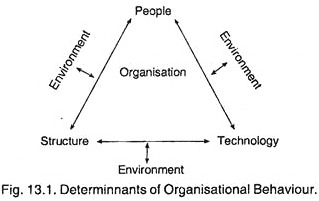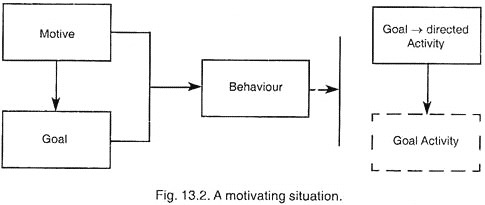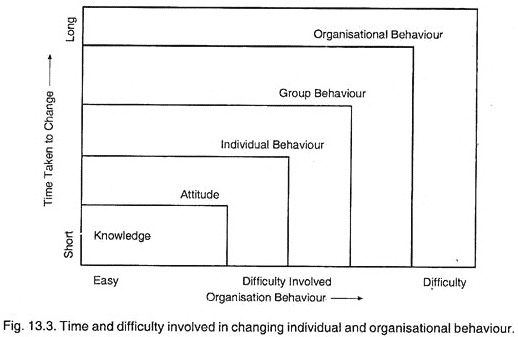Read this essay to learn about Organisational Behaviour. After reading this essay you will learn about:- 1. Introduction to Organisational Behaviour 2. Behavioural Science 3. Group Dynamics 4. Human Behaviours 5. Individual Behaviour 6. Group Behaviour.
Essay # 1. Introduction to Organisational Behaviour:
Organisational behaviour is concerned with the understanding, prediction and control of human behaviour in organisations. It focuses on the individuals, the groups, and the organisation and also on their interactional relationships. Organisational behaviour attempts to understand individuals in an organisation as a basis of meeting individual needs and achieving organisational objectives.
Organisational behaviour relies upon scientific methods to build, evaluate and modify theories about behaviour in organisations.
The scientific method involves:
ADVERTISEMENTS:
(i) Making predictions about the real world,
(ii) Making observations in the real world to determine the accuracy of predictions, and
(iii) Using the results of observations to explain relationships among objects, events or persons in the real world.
Organisational behaviour can also be defined as a field of study that investigates the impact that individuals, groups, and structure have on behaviour within organisation for the purpose of applying such knowledge toward improving an organisation’s effectiveness.
ADVERTISEMENTS:
Raman J. Aldag has defined organisational behaviour as, “a branch of the social sciences that seeks to build theories that can be applied to predicting, understanding and controlling behaviour in work organisations”. Organisational behaviour can also be defined as the study and application of knowledge about how people act within organisations.
Organisational behaviour is of integrating nature and tries to synthesize knowledge drawn from various behavioural and social sciences such as:
(i) Psychology:
It covers attitude analysis, personality analysis, organisation theory, senses and sensation, protective techniques, learning theory, morale analysis, perception and rationality.
(ii) Sociology:
It includes interpersonal relations, morale, class behavioural patterns, role and status, innovation and change, organisation theory, group behaviour, environmental influences, public opinion, formal organisation, social change, group surveys, social values and social institutions.
(iii) Anthropology:
ADVERTISEMENTS:
It includes cultural dynamics, organisation theory, Status symbols and ethnic relations.
Each of these behavioural sciences has a distinct focus of the study of human behaviour. Psychology is concerned with the analysis of individual behaviour. Sociology deals with the study of society, institutions, the organisation, the group, and norms and roles. Cultural anthropology focuses on the study of original and history of man’s cultures, their evolution and development.
The integrated knowledge of diverse behavioural sciences has the following applications:
1. Understanding of self and others. This can be studied as the individual level, inter- personnel level, group level and inter group levels.
ADVERTISEMENTS:
2. Motivation.
3. Effective communication.
4. Effective Organisational Climate.
5. Good human relation.
ADVERTISEMENTS:
6. Introduction of change in the organisation.
Study of organisational behaviour involves following key elements:
1. People,
2. Structure,
ADVERTISEMENTS:
3. Technology, and
4. Environment in which the organisation operates.
Essay # 2. Behavioural Science:
Behavioural Science is a science that studies the behaviour of men and their physical and social environment, by methods of experiments and observations in the manner of other natural sciences. Behavioural science includes psychology, sociology, social anthropology etc.
ADVERTISEMENTS:
As we know that, management is the “process of working with and through individuals and groups and other resources to accomplish organisational goals”. Management, thus defined, applies to all types of organisations, whether they may be business, industries, hospitals or educational institutes.
In leading influencing, there are three general skills (or competencies):
(a) Diagnosing – being able to understand the situation,
(b) Adapting – being able to adopt your behaviour and other resources available with you, and
(c) Communicating – being able to communicate in a way the people can easily understand and accept.
Behavioural Science integrates concepts and theories and the results of the empirical studies from the areas of cultural anthropology, economics, political science, psychology, sociology and social psychology. A behavioural scientist attempts to integrate all of those areas or disciplines which are useful in better understanding, predicting and having an impact on the behaviours of individuals and groups.
ADVERTISEMENTS:
One’s behaviour is generally motivated by a desire to attain some goal. The specific goal may or may not be conscious but known by the individual. To predict behaviour, manager must know which motives or needs of people evoke a certain action at a particular time.
Motives are the needs, wants, drives or emulses within the individuals. These are directed towards goals, which may be conscious or subconscious as mentioned earlier. ‘Goal’ may be referred to as, hope for rewards towards which motives are directed. Psychologist calls these goals as incentives.
As motives or needs are the reasons underlying behaviour of a person, and all individuals have many needs, hence all these needs comprises for the behaviour.
The blocking or delay in achievement of goal attainment leads to frustration. A person may also get frustrated by an imaginary barrier.
The relationship between motives, goals and activity is shown in the figure below:
In the figure, motives of an individual are directed towards goal attainment. The strongest motive produces behaviour that is either goal-directed or goal activities. Since not all goals are attainable, individuals do not always reach goal activity.
ADVERTISEMENTS:
As individual’s nature, they develop habit patterns. The sum of these habit patterns as perceived by others, determine their personality. As individuals begin to behave in a similar fashion under similar situations, this behaviour is what others learn to recognise by them as their personality. They expect and can even predict certain kinds of behaviour these people.
Essay # 3. Group Dynamics:
In reality, in order to accomplish our aspirations, we work in and with groups. As a leader, manager must deal with individuals differently than those with a group. These are certain complicated factors when a manager is working with groups.
Group develops personalities – customs, traditions etc. that tends to differentiate them from other groups and are characteristic of that group. Groups have modes, or patterns of behaviour as perceived by others.
The word dynamics is a Greek word, which means ‘force’. Therefore the term group dynamics refers to the forces operating in groups. The study of this subject is necessary to investigate these forces and conditions modifying them. In order to fulfill their social needs, people form small group on the job itself.
They behave as members of the group and their membership in group help to shape their work behaviour and attitude towards the organisation and the job. There is a significant change in the behaviour of a person who was acting as an individual when allowed to act as a member of some group. Groups generally exercise stronger control over their members than the management.
ADVERTISEMENTS:
Group dynamics is a social process by which people interact face to face in small groups. Group dynamics focuses a team work, wherein the small member groups are constantly in touch with each other and effectively contribute their ideas to accomplish a task.
The group develops its goal clearly. Every member participates in discussions. The group has a common objective. The group creates leaders who can coordinate group efforts effectively towards the achievement of their objectives.
Group:
A group is any number of people who:
(a) Have a common purpose or objective,
(b) Interact with each other to accomplish their objective
(c) Are aware of one another
ADVERTISEMENTS:
(d) Perceive themselves to be part of the group.
A group is formed on the basis of attraction of persons towards each other as they have similar attitudes towards common objects or goals. Common attitudes and values may be politics, religion, literature, language, work, aesthetics, traditions, authority, marriage etc.
Types of Groups:
As we know that, a group is defined as two or more people who interact with and influence each other toward a common purpose.
Mainly the groups are of two types:
(A) Formal Groups:
These are the groups created for carrying out certain tasks to help the organisation achieve its goals. A group composed of a manager and its employees that report to that manager is a most common type of formal group, and is known as command group. Other formal groups may be committees, task forces, project teams etc. created to deal with a particular problem.
ADVERTISEMENTS:
(B) Informal Groups:
These are the groups formed within the formal organisation structures, formed by coming people together and interacting regularly e.g., a cricket team of the organisation.
These groups perform following functions:
(i) To maintain and strengthen the norms and values of the members.
(ii) To give feelings of the social security, status and satisfaction.
(iii) To develop the informal channels of communication.
(iv) To help in solving their problems.
Informal groups are important not only from the point of view of their members; they also have utility from organisation’s point of view.
They are helpful to the organisation by performing following functions:
1. Solving work problems themself.
2. Better co-ordination.
3. Channel of communication.
4. Better relations.
The informal groups may create the following problems for the organisation:
1. Negative attitude of informal leaders,
2. Resistance to change,
3. Rumour, and
4. Role conflict due to working in informal group and formal group.
Group Cohesiveness:
Cohesiveness of any group depends upon status, size, location and nature of group. For meeting strategic, goals cooperation become more vital, for which cohesiveness needs to be strengthened by introducing competition, increasing interpersonal attraction, increase interaction, and create common goals and fates.
Essay # 4. Human Behaviours:
Following are the main features in this respect:
i. Performance of an individual is affected by his own characteristics, like brain, qualifications, abilities, motivation, nature etc.
ii. Every individual has unique behaviour.
iii. Individuals collect and form groups within which they live.
iv. Individuals differ and therefore paid at different rates, assigned different jobs.
v. The differences in individuals can be classified in following two categories:
(a) Individual Variables:
i. Physical characteristics.
ii. Intellectual factors.
iii. Interest and motivation.
iv. Temperament.
v. Character.
vi. Experience.
vii. Age and sex.
viii. Aptitude.
ix. Personality characteristics.
(b) Situational Variables:
i. Physical environment.
ii. Work place and its lay out.
iii. Design and condition of work equipment.
iv. Method of work.
v. Organisational set up.
vi. Kind and style of supervision.
vii. Types of incentives.
ix. Social environment.
i. An organisation has formal and informal groups. Formal groups are formed from function requirement, while informal groups are formed by employees themself due to their social and security needs, common interests and other psychological factors.
ii. An employee behaves differently in a group. Group influences the attitude and behaviour of an individual.
iii. Each group has its own cultural pattern, and individual for stay in this group must conform to this culture, if he has to remain in the group.
iv. Groups also differ in their degree of cohesiveness.
v. Group behaviour may beneficial as well as detrimental for the organisation and management depending upon the attitude of the group. Generally chances are for detrimental in nature.
Essay # 5. Individual Behaviour:
The individuals behave differently depending upon their motivation, learning, values and perception they have. The behaviour of an individual is influenced by various factors. Some of the factors are related to himself e.g., his instincts, personality traits, internal feelings etc. while some others are related outside him comprising the external environment of which he is a part.
The individual behaviour is not a self-induced phenomenon, but is affected by a larger system e.g., group, family, and the society within which one functions. Individuals behave differently in different situations because of a multitude factors such as individual’s age, sex, education, intelligence, personality, physical characteristics, experience, values, and family and cultural background.
Factors influencing individual behaviour are:
1. Personality. It includes biological, family, social, situational and other factors.
2. Ability. It includes knowledge, aptitude, skill etc.
3. Perception.
4. Motivation.
5. Organisational factors.
6. Socio-cultural factors.
7. Attitude.
Perception:
Perception is the viewpoint by which one interprets a situation. Visual perception or seeing, which plays an important role in our daily life is very complex phenomenon. People differ in the ways they perceive the things surrounding them. What we see is dependent upon the way the brain organises the nervous impules which come from the eye.
Our perception is usually dependent upon the frame or background or the context in which we see things. People also differ in the ‘rapidity’ with which they perceive. Size of the visual also assumes the importance in perception. The perception can be improved by learning and training only up to some extent.
Perception may be defined “as a process by which individuals organise and interpret their sensory impressions in order to give meaning to their environment”. Perception includes all those processes by which an individual receives information about his environment (seeing, hearing, feeling, testing and smelling), select, organise and interpret them. Through perception, people process information input into decisions and actions.
Since people working in an organisation differ in terms of physical characteristics (such as age, sex etc.), background characteristics (such as training, education, culture, social environment etc.), and personality traits, they do not view the things in the same way and generally there is difference of opinion and evaluation. People differ in their reaction due to differences in perception they have about things. Perception is a way of forming impressions about oneself, other people and daily life experiences.
Characteristics of the perceiver (Internal Factors):
1. Needs and motives.
2. Self-concept.
3. Beliefs.
4. Past experience.
5. Current psychological state.
6. Expectations.
7. Situation.
8. Personality.
Factors Influencing Perception (External Factors):
1. Size.
2. Frequency.
3. Intensity.
4. Status.
5. Contrast.
Stimulus Factors:
1. Similarity
2. Proximity
3. Continuity
4. Context
Perceptual Errors and Distortion:
Many times, errors creep into the perceptual interpretation of individuals.
The errors may arise due to:
1. Selective perception:
People differ in terms of their needs motives, interests etc., and they tend to perceive what is in accordance with their needs, motives and interests. At times, they distort meanings so that they may fit with what they want.
2. Projection:
It means attributing one’s own traits or characteristics to the people being judged.
3. Stereotyping:
It is the tendency for a person’s perception of another to be influenced by the social group to which he belongs.
4. Halo effect:
It refers to the tendency of drawing a general impression about an individual based on a single characteristic such as intelligence, sociability or appearance.
5. Impression.
6. Inference.
7. Previously held beliefs.
Attitudes:
Attitudes may be defined as learned orientation or disposition towards an object, person, situation or issue which makes an individual to react to them in a favourable or unfavourable manner.
Thus from the definition, we see that:
(i) Attitudes are learned as human being learn various other responses,
(ii) An attitude is an orientation or disposition we carry around with us just as we carry all our habits,
(iii) When the appropriate circumstances arise, the attitude makes the individual to react in a favourable, unfavourable or indifferent manner.
A person will react to a thing, person or situation depending upon the intensity of his attitude. Workers may acquire a feeling of hate or dislike towards their foreman or company or a particular department etc. that their behaviour on various company matters may become extreme resentment or even violent behaviour if the situation arises.
As we have seen that ‘attitude’ is a set of action with an emotion. It is a tendency to regard things with approval or disapproval. In case of approval, there is a feeling towards attraction for it, while in the case of disapproval; there is a feeling against or repulsion from it.
Features of attitudes:
1. Attitudes affect behaviour.
2. Attitudes are invisible.
3. Attitudes are acquired.
4. Attitudes are pervasive. Attitudes are formed in the process of socialisation e.g., positive or negative attitude towards religion, politics, work, superiors, subordinates etc.
Sources of Attitudes:
The thoughts, feelings and tendencies to behave are acquired or learned gradually.
The attitudes are acquired from the following sources:
(a) Direct personal experience,
(b) Association, and
(c) Social learning.
Although the above are the three important ways in which attitudes are learnt, but ultimately what type of attitudes will develop is dependent on following factors:
(i) Psychological factors.
(ii) Family factors.
(iii) Social factors.
(iv) Organisational factors.
(v) Economic factors.
(vi) Political factors.
Inter-Personal Relationship:
Every organisation exists either for doing a job or rendering the service with the help of human resource. In any organisation, ‘task-oriented relationship’, for combining ‘task’ with ‘human relation’ plays an important role.
Every inter-personal relationship is based on mutual and reciprocal initiating and responding behaviour pattern. It takes two parties to build it, and both are equally responsible.
Once a relationship is formed negative, positive or neutral—any late behaviour is interpreted and responded to on its basis. For example, if the existing relationship is of hostility, then any behaviour of affection will be suspected and will be indifferently responded with.
Inter-personal relationship of any type can be developed or changed through consciously planned efforts. Although change may require serious efforts.
Essay # 6. Group-Behaviour:
Group behaviour is sometimes called as human behaviour under group influence. In order to carry out certain jobs, organisation itself sets up groups for achieving goals, where collective efforts are required. Individual groups are sometimes formed by the individuals themselves because of their common interests, social needs, security etc.
Characteristics of Group Behaviour:
Following are the some of the characteristics of group behaviour:
(a) An employee behaves differently in a group than acting individually.
(b) Groups differ in their degree of cohesiveness. Some groups are strong and effective while others are loosely bound and disintegrate slowly.
(c) Every group has different culture pattern and individual member must conform to it.
(d) In case of difference of opinion either the members have to modify their views or leave the group.
(e) Group influences the attitude and behaviour of an individual towards the work and the organisation.


